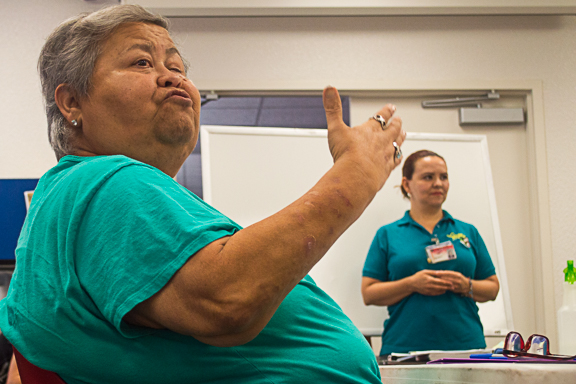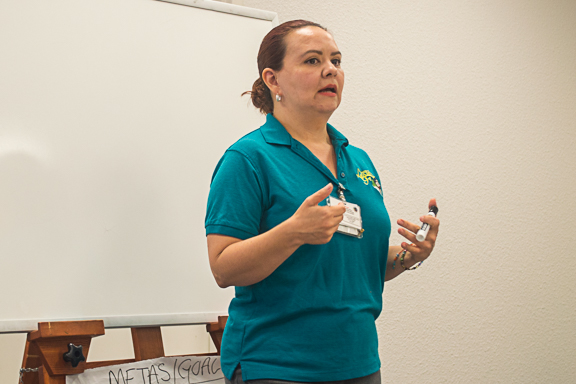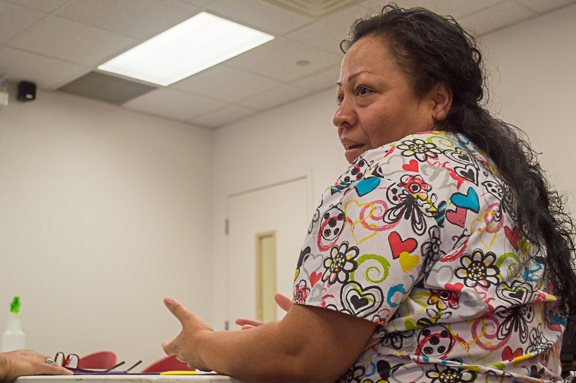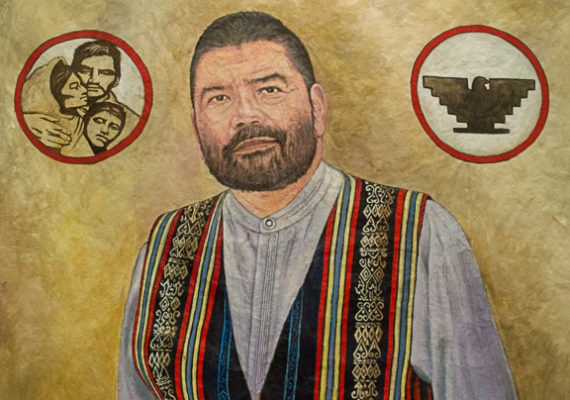By Nicole Revilla
Diabetes is on the rise nationally and in El Paso, where healthcare workers and patients are taking on the chronic disease that has been especially devastating for Hispanics.
El Paso is ranked No. 1 with the highest number of adults living with diabetes among 100 cities, according to a statistics compiled by personal finance website WalletHub.
The flow of patients is constant at Centro de Salud Familiar La Fe, a health clinic in the heart of El Paso’s Segundo Barrio, a neighborhood where many residents have low incomes and often struggle accessing healthcare.

A small banner near a series of classrooms greets patients as they receive instruction on diabetes and other helath issues. Photos by Itzel Giron for Journalism in July
The clinic and health center by the nonprofit organization offers help for those who suffer, especially people who could not afford adequate health care otherwise. It sees about 300,000 patients each year with diabetes being one of the most common diseases it treats.
On a Wednesday morning, patients waited their turn to see a doctor in La Fe’s modest building near Downtown El Paso. A posted sign shows that a typical visit costs patients $25.
In addition to the access to medical professionals, La Fe offers free diabetic education classes to help sufferers learn useful skills in living with their disease, such as how to cook health conscious meals and carry a positive mindset.

Leticia Rodriguez speaks about her battle with diabetes to the rest of the class during a Diabetes Education class.
Leticia Rodriguez, a student of this class, offered some feedback and advice that has helped her through four decades of dealing with diabetes, which can be a costly challenge.
Rodriguez, 66, said she takes insulin shots that anywhere else would cost her up to $400 a month.
However, Rodriguez, whose income qualifies her for benefits at La Fe, pays only $28 monthly for her insulin medication.
The kind of healthcare and support offered by La Fe has never been more important. About 40 percent of U.S. adults are expected to develop Type 2 diabetes, according to the Center for Diseases Control and Prevention. That number will climb higher for Hispanics – more than 50 percent, the CDC reports.

Media relations administrator, Estela Reyes, stands in front of a mural of revolutionary Ernesto ‘Che’ Guevara at Centro La Fe.
“There isn’t a single person in our community who has not been touched by this horrible and chronic disease,” said Estela Reyes Lopez, media relations administrator for La Fe and a diabetic. “Even if you don’t have it yourself, you have it in your life.”
“It’s a disease that if you don’t manage it or control it, it will control you.” Reyes said.
Looming above the financial hardships of taking on the disease are possible complications from Type 2 diabetes such as blindness, amputation, kidney failure, ischemic heart disease and stroke.
Centers like La Fe are helping El Pasoans suffering from diabetes and also a myriad of other health conditions in providing resources, access to medication and education about their disease.
The challenge of living with diabetes can be more difficult for people from low-income backgrounds, Reyes said. It’s expensive to be diabetic. Annual health care costs for diabetics are more than double than those without the condition in the United States.
The cost of insulin has been increasing every year. A vial of insulin costs up to $400. Patients with Type 1 diabetes typically require two or three vials of insulin per month, but patients who are more resistant to insulin, such as those with Type 2 diabetes, may require six or more.
Many diabetic patients must first accept a diagnosis of diabetes and all of the changes that will be required to deal with the disease, said Monica Cedillos, a nutritionist who teaches the diabetes education class at La Fe.

Monica Sedillos leads a diabetes class at Centro de Salud Familiar La Fe.
That means learning how to take responsibility for one’s health, from transitioning to a healthier diet to exercising more, Cedillos said.
“Even little changes to your lifestyle can help your body tremendously,” she said. “Small changes in your eating habits and even small walks help.”
Diabetic patients should be aware of their condition and take care of themselves. Regular checkups with physicians, staying on track of blood sugar levels and never falling behind on medications are all key to successful treatment.
“It takes a lot of work and commitment to do the things you need to do for your health.” Rodriguez said.
La Fe’s diabetes class focuses on setting up realistic goals for each of its participants and provide motivation to accomplish them.

Veronica Espinoza, an employed caregiver and diabetic, talks about all the help La Fe has provided herself and family.
“I’ve learned a lot of things in my class, I’ve learned things I didn’t even know how to do with diabetes. It’s good to look for help,” said Veronica Espinoza, another student of La Fe’s diabetes class.
Family support is also crucial for diabetic patients. The class is also open to family members of patients to sit in on classes and learn ways they can be supportive of their loved ones.
“It’s a lot more difficult for a diabetic to stay on track of their disease when their family members aren’t making the effort to eat healthy with them,” Cedillos said, adding that El Paso’s bounty of Mexican cuisine becomes a challenge.
La Fe’s mission to help low-income El Pasoans receive quality healthcare does not stop at just treating those with diabetes. With 11 clinics operating all over the El Paso area, La Fe also offers dental care, ophthalmologists, an HIV/AIDS treatment center, operates its own pharmacy center, among other services.
“There’s a lot of places that offer help. I knew I had diabetes but since I didn’t have insurance, I was always worrying, ‘well how am I going to pay for the doctor?’” Espinoza said, “… but there’s places like La Fe that I could’ve found a long time ago, but thankfully now I have,” she said.
This story was produced as part of the Journalism in July 2018 workshop for high school students at UT El Paso.

One of the biggest murals in the clinic is of Salvador Balcorte, CEO of Centro La Fe.

